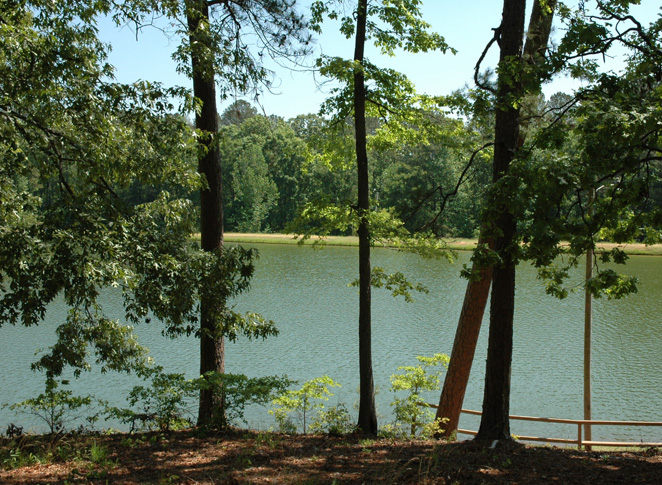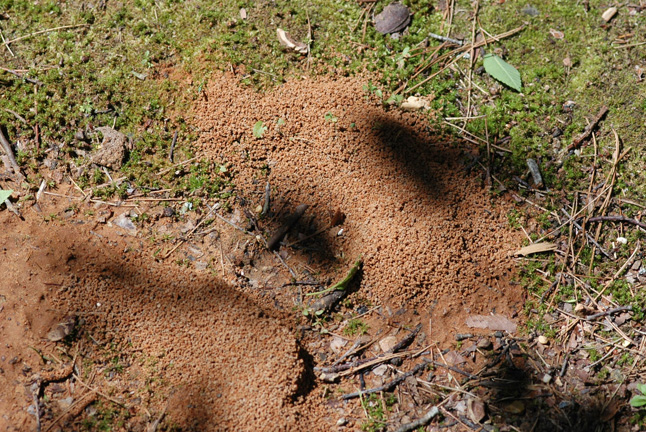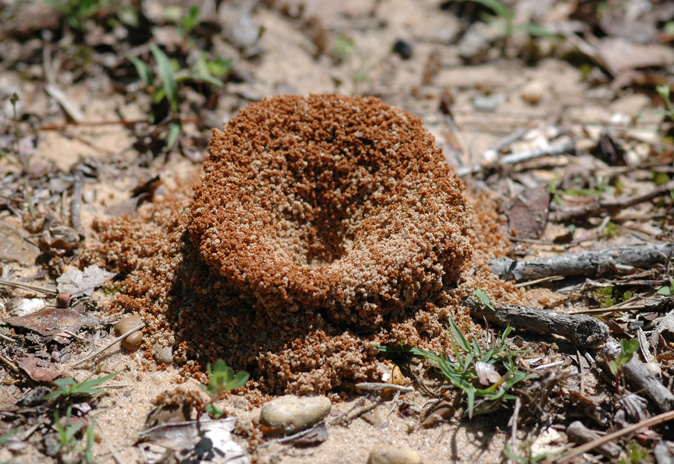Ants in Golden Memorial Park, Scott County, Mississippi, 27 April 2006 [MS State Park Ants]
Joe A. MacGown and JoVonn G. Hill
Golden Memorial Park is a small park located in Scott County, Mississippi. The park is mostly centered around a small 15 acre lake, which is surrounded by an open wooded area along the road into the park and by mixed pine-deciduous forest around the lake. The park is five miles east of Walnut Grove off of Mississippi highway 35. Many of the pines present were shortleaf pine (Pinus echinata P. Miller) and oak species we noticed were white (Quercus alba L.) and blackjack (Quercus marilandica Muenchh.). Other hardwoods and small trees were present as well, such as sweet gum (Liquidambar styraciflua L.), plenty of flowering dogwood (Cornus florida L.), beautyberry (Callicarpa americana L.), and Styrax spp. The area around the lake was planted in ryegrass (Lolium multiflorum Lam.) and there was scattered broom sedge (Andropogon virginicus L.). The entrance area is much higher in elevation than the surrounding area with the rest of the park being lower in elevation. The soil on the hilltop area near the entrance was intermixed with red clay, but was still more on the sandy side, whereas the soil in the forested areas was a mix of sand and accumulated litter from trees, which resulted in a much richer soil. Much of the area was littered with scattered downed trees, which probably were damaged from Hurricane Katrina, in the fall of 2005.

A view of the lake at Memorial State Park
On 27 April 2006 Joe MacGown, JoVonn Hill, and Greg Christadoulou collected ants and various other insects at Golden Memorial State Park. Greg was actually more interested in aquatic insects and he spent most of his time collecting at the edge of the lake. In addition to ants, JoVonn also spent some time looking for grasshoppers. We arrived at the park around 9:30 A.M. on a beautiful sunny day with mild temperatures only reaching in the mid 70's. We parked beside the small office to see if we could find anyone to talk to and let them know what we were up to, but no one was there.
As soon as we got out of the vehicle, we noticed the distinctive nest sites of Trachymyrmex septentrionalis (McCook) at the top of the hill beside the office. Their nests are easy to spot as they typically have a crescent shaped mound of soil on one side of the entrance hole to the colony. Their colony was in the soil, which was a mix of sand and red clay. Representative workers were collected by digging into the colony with a small garden shovel and afterward the soil that was removed was placed back into the hole. Trachymyrmex are very specialized ants that grow subterranean fungus gardens using a variety of vegetative and animal materials for a substrate. The ants use this fungus as their primary food source. While collecting these ants we noticed that they had already established a nice sized fungus garden. Colonies of this species were scattered throughout the park, especially on the sloped areas.

Crescent mounds of soil beside the entrance hole of Trachymyrmex septentrionalis.
Located almost side by side with the Trachymyrmex nests we found colonies of Nylanderia arenivaga (Wheeler), which we also collected specimens of. This yellowish colored species usually nests in sandy soils and has the nest entrances surrounded by small craters of soil. This species was also seen at several other locations in the park, especially in open sandy areas with little slope.

The crater surrounding the entrance hole to a colony of Nylanderia arenivaga.
Similar to many areas in Mississippi, there was a great abundance of the imported red fire ant, Solenopsis invicta Buren, present in the park. Colonies were present throughout the park, even in the forested areas. However, unlike colonies of the black imported fire ant, Solenopsis richteri Forel, and the hybrid fire ant, Solenopsis invicta X richteri, which have large mounds, the colonies present here were somewhat small. Colonies were especially noticeable along the sides of the roadway and parking areas, in the open picnic areas, at bases of trees, and along the trail surrounding the lake, but were also seen in great numbers in the forested areas under bark of various dead trees.
Just across the road from the office was a small open sandy area where Brachymyrmex patagonicus Mayr were seen scurrying about. This extremely small, dark brownish-black ant is an introduced ant native to Central America. Small bits of cookie bait was placed on the ground near them and as workers picked up pieces, they carried them back to their colony, which was in the soil under a rock approximately 2 cm wide, 4 cm long, and 2 cm high.
As we walked toward the lake, the landscape became more sloped with several large trees present. A picnic area was located in this spot. It was in this area that we put peanut butter bait on several of the larger trees, Quercus spp. and short-leaf pine, at approximately eye level. We use peanut butter in this manner to attract arboreal ants. We also placed 10 bait stations with Pecan Sandies cookies at the bases of some trees in the same area and a few near some downed trees. The peanut butter bait was checked periodically, but only two species, Prenolepis imparis (Say) and Crematogaster ashmeadi Mayr, were collected. These species were only found on Quercus spp. and no ants were seen at the bait on the short-leaf pines. The Prenolepis were also very common elsewhere and were seen running about on the ground in this area. This species is not arboreal, but nests in the soil. However, C. ashmeadi is typically an arboreal nesting species and was probably nesting under the bark or in the upper reaches of the tree somewhere. Six of the cookie bait stations had ants in them, whereas the other four had no ants in them (at least at the time when they were picked up). Ants collected at these stations were P. imparis, S. invicta, Pheidole metallescens Emery, and C. ashmeadi. No overlap between species was seen at any bait station and it appeared to be first come first serve with whatever species that got there first getting the bait. Pheidole metallescens is a beautiful ant species that has a dimorphic worker caste with major and minor workers. Minors of this species are dark colored and they have a brilliant bluish-purple iridescent sheen. This species is common in many sandy habitats and nests were seen scattered throughout this area. The black carpenter ant, Camponotus pennsylvanicus (DeGeer), was collected crawling around the picnic area as well, which is not surprising, as this is a ubiquitous ant often seen at places frequented by people. Collections in the soil and litter at the base of a large blackjack oak tree whose top was knocked off and lying on the ground yielded Camponotus chromaiodes Bolton, Hypoponera opacior (Forel), and P. metallescens.
After collecting in the picnic area for a while, we headed past the nearby pavilion and collected on the trail that surrounded the lake. One area that proved to be fruitful for ants was a little sun-dappled spot with oak and short-leaf pine litter strewn about. Underneath this layer of leaf litter many blackish colored, medium sized ponerines were seen running around, of which a sample was collected. They were later identified as Hypoponera opaciceps (Mayr). This species appears to be more common in the southern half of the state and we have collected them in similar habitats before. Some Dorymyrmex bureni (Trager) were seen running rapidly (as they always do) in the same area. Cookie crumbs were placed in near them and they grabbed pieces and immediately headed to their colony. These ants thrive in sandy soils and it was not unexpected that we would find them here. Also found under the litter on the trail were many of the small tenebrionid beetle, Poecilocrypticus formicophilus Gebien. This species is thought to be a myrmecophile associated with the imported fire ant (MacGown, 2005). In addition to these ants, a gallon bag of litter and soil was also collected from the trail area here and taken to the laboratory for Berlese funnel extraction. Ant species found in this sample included D. bureni, Brachymyrmex depilis Emery, H. opaciceps, Strumigenys ornata, Solenopsis invicta, S. sp. cf. molesta, and P. metallescens.
In this same area a colony of Camponotus chromaiodes was found in the soil at the base of a short-leaf pine tree. When some leaf litter was pulled back hordes of them came boiling forth. A couple of handfuls of the nest were thrown in a shallow collecting pan and a few representatives were placed in a vial. At the base of the same tree a colony of Pheidole metallescens was found nesting under bark. Only one major worker was collected, but a good sample of the minor workers was taken. This was the first time we had seen this species nesting under bark. Previous colonies we have found were in soil (usually sandy soil).
An abundance of fire ant nests, many of which appeared to have been dug into by some sort of animal, possibly an armadillo were also seen along the trail. While walking along the trail, hollow stems of grasses growing beside the lake were looked at to see if any ants were nesting in there. One species, Crematogaster pilosa Emery, was found in this manner. This species is often found nesting in hollow stems and we have found it in a variety of habitats. A dead specimen of Camponotus nearcticus Emery was seen on the trail and collected.
After walking the lake trail for a while, collections were next made in the adjacent forest. The area here was a mix of several hardwoods and pines. There were many dead trees on the ground, probably from last years hurricane Katrina, but some older ones as well that were rotting. Taking advantage of the downed trees, bark was pealed back in an effort to find ant colonies. Many colonies S. invicta were found in this manner. Under the bark of one hardwood tree where S. invicta was found, a colony of Crematogaster lineolata (Say) was also found only a few centimeters away. Until the bark was pulled back, these two species were apparently living in harmony, but all bets were off afterward. The Crematogaster scattered and left their brood where it was, whereas the Solenopsis soon swarmed the entire area with some workers carrying off the Crematogaster brood. Under the bark of a Pinus sp. tree a dealate queen and workers of Aphaenogaster lamellidens Mayr were collected. A soil and leaf litter sample was collected along a rotting log on the ground and one more litter sample was collected at the base a shortleaf pine in an area not far away that was mostly deciduous. Strumigenys ornata, Strumigenys louisianae Roger, and Myrmecina americana Emery were found in this litter sample. Two adults of the myrmecophilous cricket, Myrmecophilus pergandei Bruner, were also found in that sample. This species was only recently reported to occur in Mississippi (MacGown and Hill, 2006).
Collections of ants were also made on the nature trail that started down from the office area and went through a mixed deciduous-pine forest with some hills and ravines. Litter was collected from an area between the base of an oak and a fallen log. Continuing up the trail an area was found with several sections of cut trees on the ground that had probably fallen across the trail during hurricane Katrina last year and later been cut. Two Stigmatomma pallipes (Haldeman) workers were collected under each of two smaller logs. These primitive ponerines with their amazing long mandibles with bidentate teeth are often seen in this sort of setting and we have found them throughout the state. After these two specimens were collected, litter was scooped up and sifted from where the logs had been. No other Stigmatomma were found, nor was much else of interest seen except some small centipedes. Next, the larger pieces of wood were looked under for ants. Upon rolling a section of what was the trunk of the tree a Camponotus chromaiodes queen in an excavated crater in the bark, was found. The crater was just a littler larger than the queen and contained a clutch of about 15 eggs. Other ants found under logs were Ponera pennsylvanica Buckley and Aphaenogaster carolinensis Wheeler. Several other sections of trunk were searched with no other ants being found, as the wood was in the early stages of decay. A Berlese litter sample was collected in this area as well, and Strumigenys hexamera (Brown), S. ohioensis Kennedy & Schramm, Solenopsis sp. cf. molesta, Aphaenogaster sp. cf. carolinensis, and Myrmecina americana were later found in the sample. Both S. hexamera and S. ohioensis were only recently discovered to occur in Mississippi (MacGown et al, 2005). Strumigenys hexamera is an introduced species from Japan. Prior to recent collections in this state, it was considered to be a very rare species in North America. However, it has now been collected in at least 10 counties in Mississippi. This particular sample included 16 workers and 1 dealate female.
Further up the trail a small open area on top of a hill was encountered. There was some broom sedge and some bare patches of ground. One of the first things noticed was a fire ant colony that appeared to have been dug into by some animal. In the center of the depression created by the intruding animal, a clump of fire ants was observed apparently attacking something. Disturbing the ants caused them to scatter and revealed the source of their attention be a small scarab beetle, which was upside down. However, after the ants left the scarab managed to roll over and began to walk away, with no obvious ill effects. The scarab beetle was collected and later identified as Martineziella dutertrei, a known myrmecophile of the imported fire ants.
In the surrounding area a colony of Nylanderia arenivaga was found with several fire ant bodies scattered around the entrance. A colony of the fast moving dolichoderine, Forelius mccooki (McCook) was also found in this area. A small Strumigenys species, which we later identified as S. reflexa , was collected from soil from inside and around a clump of broom sedge, which was scraped away and placed it into a collecting pan. Other ants in the same sample included some fire ants, Monomorium minimum (Buckley), and Nylanderia faisonensis (Forel). Myrmecina americana Emery was also found under a clump of broom sedge. This is somewhat unusual as we typically find this species under rotting wood or in litter at bases of trees. This area was searched further and some grasshoppers were collected.
Although Golden Memorial State Park is relatively small, 31 species of ants were collected in approximately two hours and many more species likely occur there.
List of ant species collected (arranged alphabetically by genus)
Aphaenogaster carolinensis (Wheeler)
Aphaenogaster lamellidens Mayr
Brachymyrmex depilis Emery
Brachymyrmex patagonicus Mayr
Camponotus chromaiodes Bolton
Camponotus nearcticus Emery
Camponotus pennsylvanicus (DeGeer)
Crematogaster ashmeadi Mayr
Crematogaster lineolata (Say)
Crematogaster pilosa Emery
Dorymyrmex bureni (Trager)
Forelius mccooki (McCook)
Formica dolosa Buren
Hypoponera opaciceps (Mayr)
Hypoponera opacior (Forel)
Monomorium minimum (Buckley)
Myrmecina americana Emery
Nylanderia arenivaga (Wheeler)
Nylanderia faisonensis (Forel)
Pheidole metallescens Emery
Ponera pennsylvanica Buckley
Prenolepis imparis (Say)
Solenopsis invicta Buren
Solenopsis sp. cf. molesta (Say)
Stigmatomma pallipes (Haldeman)
Strumigenys hexamera (Brown)
Strumigenys louisianae Roger
Strumigenys ohioensis Kennedy & Schramm
Strumigenys ornata Mayr
Strumigenys reflexa Wesson & Wesson
Trachymyrmex septentrionalis (McCook)
MacGown, J. A., R. L. Brown, and J. G. Hill. 2005. An annotated list of the Pyramica (Hymenoptera: Formicidae: Dacetini) of Mississippi. Journal of the Kansas Entomological Society 78: 285–289. [pdf]
MacGown, J. A. 2005. A Collection of Poecilocrypticus formicophilus Gebien (Coleoptera: Tenebrionidae) from a mound of the imported fire ant hybrid, Solenopsis invicta X richteri (Hymenoptera: Formicidae) in Mississippi, USA. Entomological News 116: 367-368. [pdf]
MacGown, J. A. and J. G. Hill. 2006. The Eastern ant cricket, Myrmecophilus pergandei Bruner (Orthoptera: Myrmecophilidae), reported from Mississippi, U.S.A. Journal of the Mississippi Academy of Sciences 51: 180-182. [pdf]


